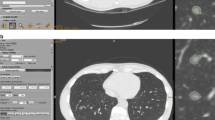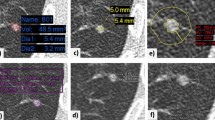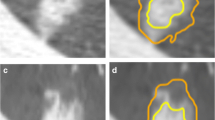Abstract
Purpose
This study was done to evaluate the variability of semiautomated volume measurements of solid pulmonary nodules between two different versions of the same volumetric software.
Materials and methods
The volumes of 100 solid intraparenchymal nodules (mean volume 88.10 mm3; range 7.36–595.25 mm3) studied with the same multidetector computed tomography (MDCT) protocol were determined using two different versions of the same volumetric software (LungCARE 2006G and LungCARE 2007S). The 2006G version is based on a single-segmentation algorithm, whereas the newer version features two algorithms: SmallSizeNodule and AllSizeNodule. The results obtained with the 2006G version were compared with those of the 2007S version with the SmallSizeNodule algorithm, as recommended by the user manual. In addition, we compared the volumetric measurements obtained by the two different algorithms of the 2007S version.
Results
The 2006G version and the 2007S version with the SmallSizeNodule algorithm agreed in only two of 100 cases and showed a mean variability of 1.66% (range 0%–8.78%). A more significant volumetric discrepancy was observed between the two different algorithms of the 2007S version, with the AllSizeNodule algorithm providing on average larger volumes (mean variability 71.08%; range 6.02%–218.80%) than SmallSizeNodule. Volume discrepancies were more pronounced in the subgroups of smaller nodules in all comparisons.
Conclusions
There is variability also in the results provided by different versions of the same volumetric software, and this may affect the calculation of the nodule-doubling time. Computer-aided assessment of the growth of lung nodules should always be performed using the same version of volumetric software and the same segmentation algorithm.
Riassunto
Obiettivo
Scopo del nostro studio è stato valutare la variabilità delle misurazioni volumetriche di noduli polmonari solidi dovuta all’utilizzo di diverse versioni dello stesso software di volumetria.
Materiali e metodi
I volumi di 100 noduli polmonari solidi intraparenchimali (volume medio di 88,10 mm3; range 7,36–595,25 mm3) sottoposti a tomografia computerizzata (TC) multidetettore con lo stesso protocollo d’esame sono stati misurati con 2 versioni diverse dello stesso software di volumetria (LungCARE 2006G e LungCARE 2007S). La versione 2006G presenta un unico algoritmo di segmentazione mentre la versione 2007S è dotata di 2 algoritmi chiamati SmallSizeNodule e AllSizeNodule. I risultati della versione 2006G sono stati confrontati con quelli della versione 2007S ottenuti con l’algoritmo SmallSizeNodule come consigliato dal manuale del software. Sono stati inoltre confrontati tra loro i risultati delle volumetrie ottenute con i diversi algoritmi della versione 2007S.
Risultati
La versione 2006G e la versione 2007S con algoritmo SmallSizeNodule hanno dato un risultato sovrapponibile solo in 2 casi su 100 ed hanno esibito una variabilità volumetrica media dell’1.66% (range 0%–8,78%). Una discrepanza volumetrica assai maggiore è stata osservata tra i 2 diversi algoritmi di segmentazione della versione 2007S in cui l’algoritmo AllSizeNodule ha fornito volumi mediamente superiori del 71,08% (range 6,02%–218,80%) rispetto all’algoritmo SmallSizeNodule. L’entità delle discrepanze volumetriche è risultata maggiore nei sottogruppi di noduli di minori dimensioni in tutte le comparazioni eseguite.
Conclusioni
Anche tra diverse versioni dello stesso software di analisi volumetrica esiste una variabilità di risultati che può influenzare il calcolo del tempo di raddoppiamento dei noduli. La valutazione computerizzata del tasso di crescita di un nodulo polmonare andrebbe eseguita utilizzando nei vari controlli sempre la stessa versione del software di volumetria ed il medesimo algoritmo di segmentazione.
Similar content being viewed by others
References/Bibliografia
Revel MP, Bissery A, Bienvenu M et al (2004) Are two-dimensional CT measurements of small noncalcified pulmonary nodules reliable? Radiology 231:453–458
Das M, Ley-Zaporozhan J, Gietema HA et al (2007) Accuracy of automated volumetry of pulmonary nodules across different multislice CT scanners. Eur Radiol 17:1979–1984
Honda O, Sumikawa H, Johkoh T et al (2007) Computer-assisted lung nodule volumetry from multi-detector row CT: Influence of image reconstruction parameters. Eur J Radiol 62:106–113
Larici AR, Storto ML, Torge M et al (2008) Automated volumetry of pulmonary nodules on multidetector CT: influence of slice thickness, reconstruction algorithm and tube current. Preliminary results. Radiol Med 113:29–42
de Hoop B, Gietema H, van Ginneken B et al (2008) A comparison of six software packages for evaluation of solid lung nodules using semi-automated volumetry: What is the minimum increase in size to detect growth in repeated CT examinations. Eur Radiol 19:800–808
Siemens Medical (2006) SyngoCT 2007S. Istruzione d’uso. Volume 4. Siemens Medical, Muenchen
Fischbach F, Knollmann F, Griesshaber V et al (2003) Detection of pulmonary nodules by multislice computed tomography: improved detection rate with reduced slice thickness. Eur Radiol 13:2378–2383
Diederich S, Wormanns D, Semik M et al (2002) Screening for early lung cancer with low-dose spiral CT: prevalence in 817 asymptomatic smokers. Radiology 222:773–781
Roberts HC, Patsios D, Paul NS et al (2007) Lung cancer screening with low-dose computed tomography: canadian experience. Can Assoc Radiol J 58:225–235
Kim YH, Lee KS, Primack SL et al (2002) Small pulmonary nodules on CT accompanying surgically resectable lung cancer: likelihood of malignancy. J Thorac Imaging 17:40–46
MacMahon H, Austin JHM, Gamsu G et al (2005) Guidelines for management of small pulmonary nodules detected on CT scans: a statement from the Fleischner Society. Radiology 237:395–400
Goodman LR, Gulsun M, Washington L et al (2006) Inherent variability of CT lung nodule measurements in vivo using semiautomated volumetric measurements. AJR Am J Roentgenol 186:989–994
Wormanns D, Diederich S (2004) Characterization of small pulmonary nodules by CT. Eur Radiol 14:1380–1391
Gietema HA, Wang Y, Xu D et al (2006) Pulmonary nodules detected at lung cancer screening: interobserver variability of semiautomated volume measurements. Radiology 241:251–257
Revel MP, Lefort C, Bissery A et al (2004) Pulmonary nodules: preliminary experience with three-dimensional evaluation. Radiology 231:459–466
Jennings SG, Winer-Muram HT, Tarver RD, Farber MO (2004) Lung tumor growth: assessment with CT. Comparison of diameter and cross-sectional area with volume measurements. Radiology 231:866–871
Revel MP, Merlin A, Peyrard S et al (2006) Software volumetric evaluation of doubling times for differentiating benign versus malignant pulmonary nodules. AJR Am J Roentgenol 187:135–142
Chest Xray Doubling Time Calculator. Published June 2000, revised July 2004. Available at: http://www.chestxray.com/SPN/DoublingTime.html. Accessed October 2009
Gietema HA, Schaefer-Prokop CM, Mali WPTM et al (2007) Pulmonary nodules: interscan variability of semiautomated volume measurements with multisection CT — Influence of inspiration level, nodule size, and segmentation performance. Radiology 245:888–894
Boll DT, Gilkeson RC, Fleiter TR et al (2004) Volumetric assessment of pulmonary nodules with ECG-gated MDCT. AJR Am J Roentgenol 183:1217–1223
Kostis WJ, Yankelevitz DF, Reeves AP et al (2004) Small pulmonary nodules: reproducibility of three-dimensional volumetric measurement and estimation of time to follow-up CT. Radiology 231:446–452
Wang Y, van Klaveren RJ, van der Zaag-Loonen HJ et al (2008) Effect of nodule characteristics on variability of semiautomated volume measurements in pulmonary nodules detected in a lung cancer screening program. Radiology 248:625–631
Petrou M, Quint LE, Nan B, Baker LH (2007) Pulmonary nodule volumetric measurement variability as a function of CT slice thickness and nodule morphology. AJR Am J Roentgenol 188:306–312
Author information
Authors and Affiliations
Corresponding author
Rights and permissions
About this article
Cite this article
Rinaldi, M., Bartalena, T., Braccaioli, L. et al. Three-dimensional analysis of pulmonary nodules: variability of semiautomated volume measurements between different versions of the same software. Radiol med 115, 403–412 (2010). https://doi.org/10.1007/s11547-010-0511-6
Received:
Accepted:
Published:
Issue Date:
DOI: https://doi.org/10.1007/s11547-010-0511-6




